Risk Management and Human Fallibility at Balfour Beatty Plc Report
VerifiedAdded on 2023/01/11
|9
|2831
|86
Report
AI Summary
This report provides an in-depth analysis of risk management practices within Balfour Beatty Plc, a multinational construction and infrastructure company. It begins by evaluating the applicability of human fallibility in workplace risk scenarios, exploring various types of human errors such as fatigue and disregarding safety measures, and their impact on the company's operations. The report emphasizes the importance of effective management in mitigating human errors and the significance of employee training and safety protocols. It also examines the relationship between human stress and error, highlighting factors like anxiety and tight deadlines. Furthermore, the report delves into the concept of a 'just culture' and its role in building a workplace environment of openness and accountability. It discusses the importance of balancing individual and company accountability, implementing quality learning environments, and promoting employee safety. The report highlights the company's efforts to address human errors, improve safety measures, and create a culture where employees feel safe and supported. The report also touches upon the Swiss cheese model as a tool to reduce risks within the construction industry.
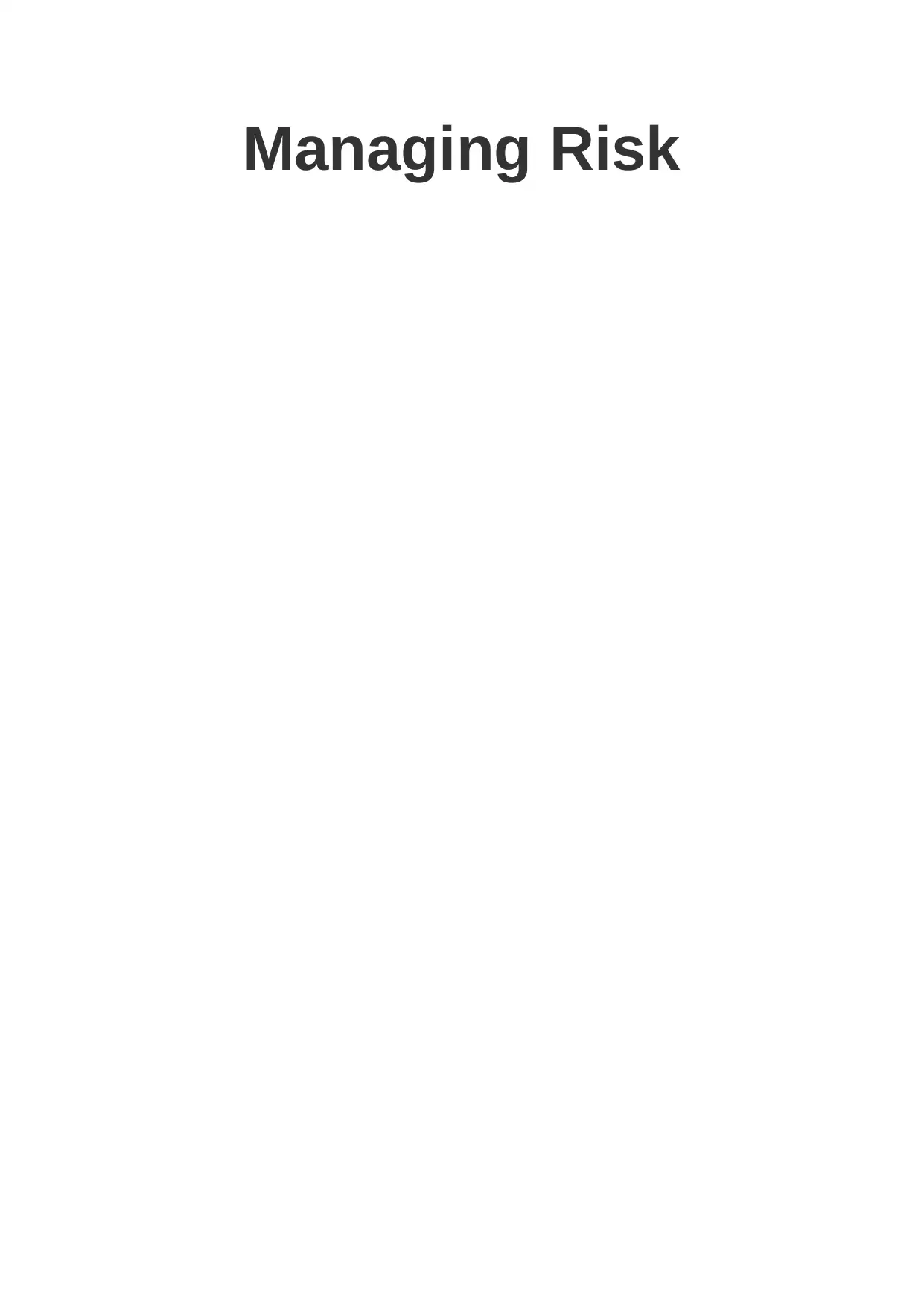
Managing Risk
Paraphrase This Document
Need a fresh take? Get an instant paraphrase of this document with our AI Paraphraser
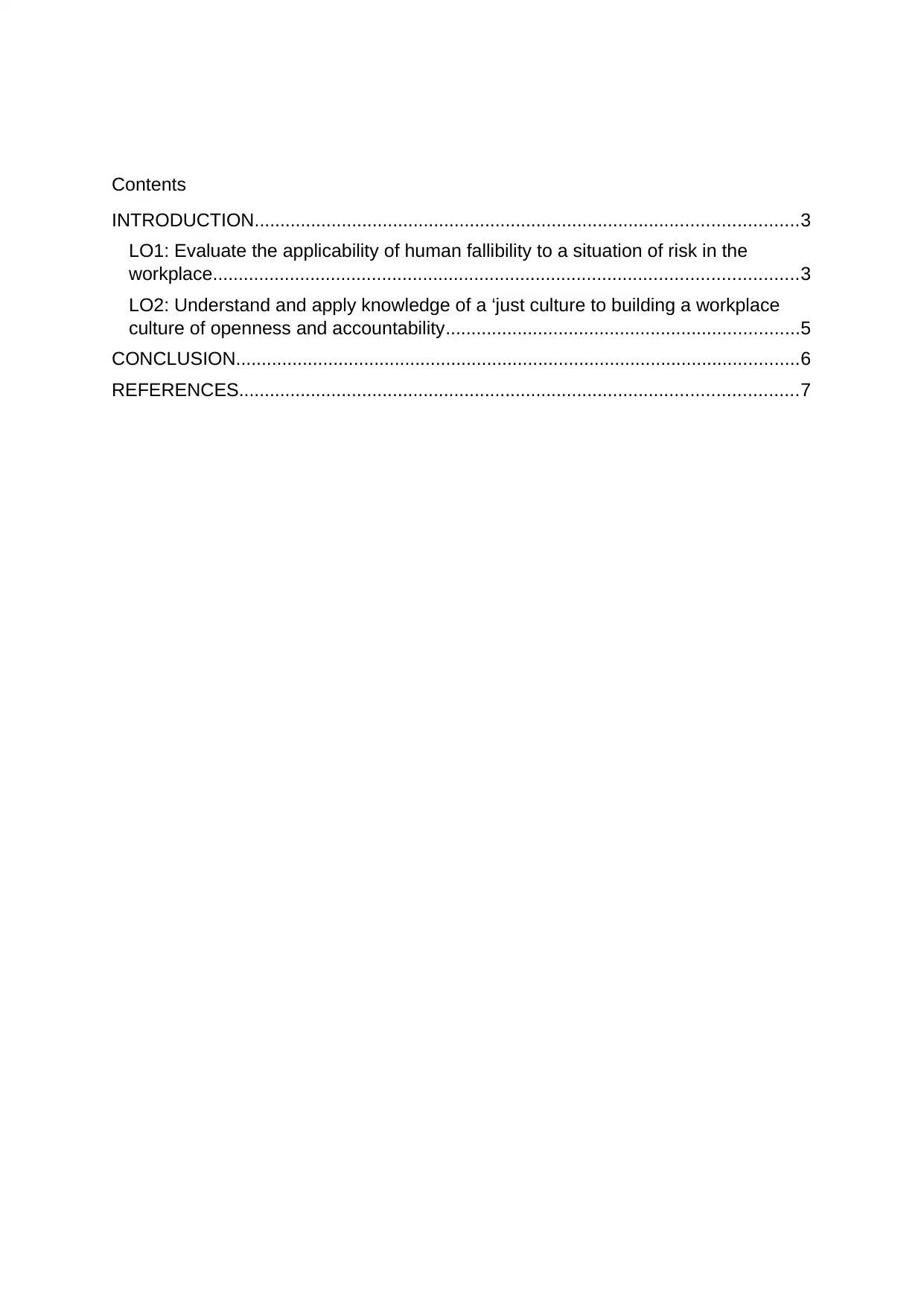
Contents
INTRODUCTION..........................................................................................................3
LO1: Evaluate the applicability of human fallibility to a situation of risk in the
workplace..................................................................................................................3
LO2: Understand and apply knowledge of a ‘just culture to building a workplace
culture of openness and accountability.....................................................................5
CONCLUSION..............................................................................................................6
REFERENCES.............................................................................................................7
INTRODUCTION..........................................................................................................3
LO1: Evaluate the applicability of human fallibility to a situation of risk in the
workplace..................................................................................................................3
LO2: Understand and apply knowledge of a ‘just culture to building a workplace
culture of openness and accountability.....................................................................5
CONCLUSION..............................................................................................................6
REFERENCES.............................................................................................................7
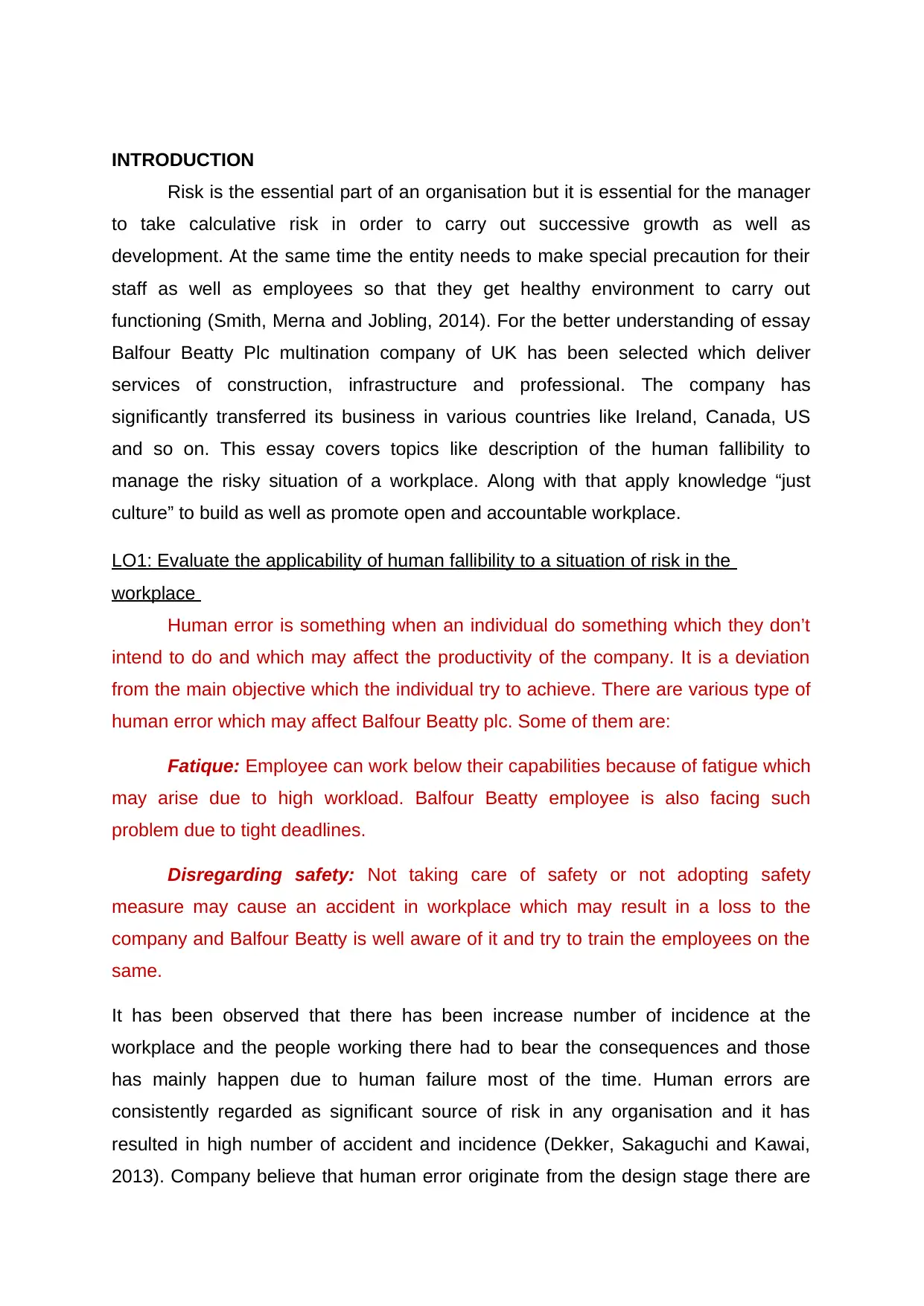
INTRODUCTION
Risk is the essential part of an organisation but it is essential for the manager
to take calculative risk in order to carry out successive growth as well as
development. At the same time the entity needs to make special precaution for their
staff as well as employees so that they get healthy environment to carry out
functioning (Smith, Merna and Jobling, 2014). For the better understanding of essay
Balfour Beatty Plc multination company of UK has been selected which deliver
services of construction, infrastructure and professional. The company has
significantly transferred its business in various countries like Ireland, Canada, US
and so on. This essay covers topics like description of the human fallibility to
manage the risky situation of a workplace. Along with that apply knowledge “just
culture” to build as well as promote open and accountable workplace.
LO1: Evaluate the applicability of human fallibility to a situation of risk in the
workplace
Human error is something when an individual do something which they don’t
intend to do and which may affect the productivity of the company. It is a deviation
from the main objective which the individual try to achieve. There are various type of
human error which may affect Balfour Beatty plc. Some of them are:
Fatique: Employee can work below their capabilities because of fatigue which
may arise due to high workload. Balfour Beatty employee is also facing such
problem due to tight deadlines.
Disregarding safety: Not taking care of safety or not adopting safety
measure may cause an accident in workplace which may result in a loss to the
company and Balfour Beatty is well aware of it and try to train the employees on the
same.
It has been observed that there has been increase number of incidence at the
workplace and the people working there had to bear the consequences and those
has mainly happen due to human failure most of the time. Human errors are
consistently regarded as significant source of risk in any organisation and it has
resulted in high number of accident and incidence (Dekker, Sakaguchi and Kawai,
2013). Company believe that human error originate from the design stage there are
Risk is the essential part of an organisation but it is essential for the manager
to take calculative risk in order to carry out successive growth as well as
development. At the same time the entity needs to make special precaution for their
staff as well as employees so that they get healthy environment to carry out
functioning (Smith, Merna and Jobling, 2014). For the better understanding of essay
Balfour Beatty Plc multination company of UK has been selected which deliver
services of construction, infrastructure and professional. The company has
significantly transferred its business in various countries like Ireland, Canada, US
and so on. This essay covers topics like description of the human fallibility to
manage the risky situation of a workplace. Along with that apply knowledge “just
culture” to build as well as promote open and accountable workplace.
LO1: Evaluate the applicability of human fallibility to a situation of risk in the
workplace
Human error is something when an individual do something which they don’t
intend to do and which may affect the productivity of the company. It is a deviation
from the main objective which the individual try to achieve. There are various type of
human error which may affect Balfour Beatty plc. Some of them are:
Fatique: Employee can work below their capabilities because of fatigue which
may arise due to high workload. Balfour Beatty employee is also facing such
problem due to tight deadlines.
Disregarding safety: Not taking care of safety or not adopting safety
measure may cause an accident in workplace which may result in a loss to the
company and Balfour Beatty is well aware of it and try to train the employees on the
same.
It has been observed that there has been increase number of incidence at the
workplace and the people working there had to bear the consequences and those
has mainly happen due to human failure most of the time. Human errors are
consistently regarded as significant source of risk in any organisation and it has
resulted in high number of accident and incidence (Dekker, Sakaguchi and Kawai,
2013). Company believe that human error originate from the design stage there are
⊘ This is a preview!⊘
Do you want full access?
Subscribe today to unlock all pages.

Trusted by 1+ million students worldwide
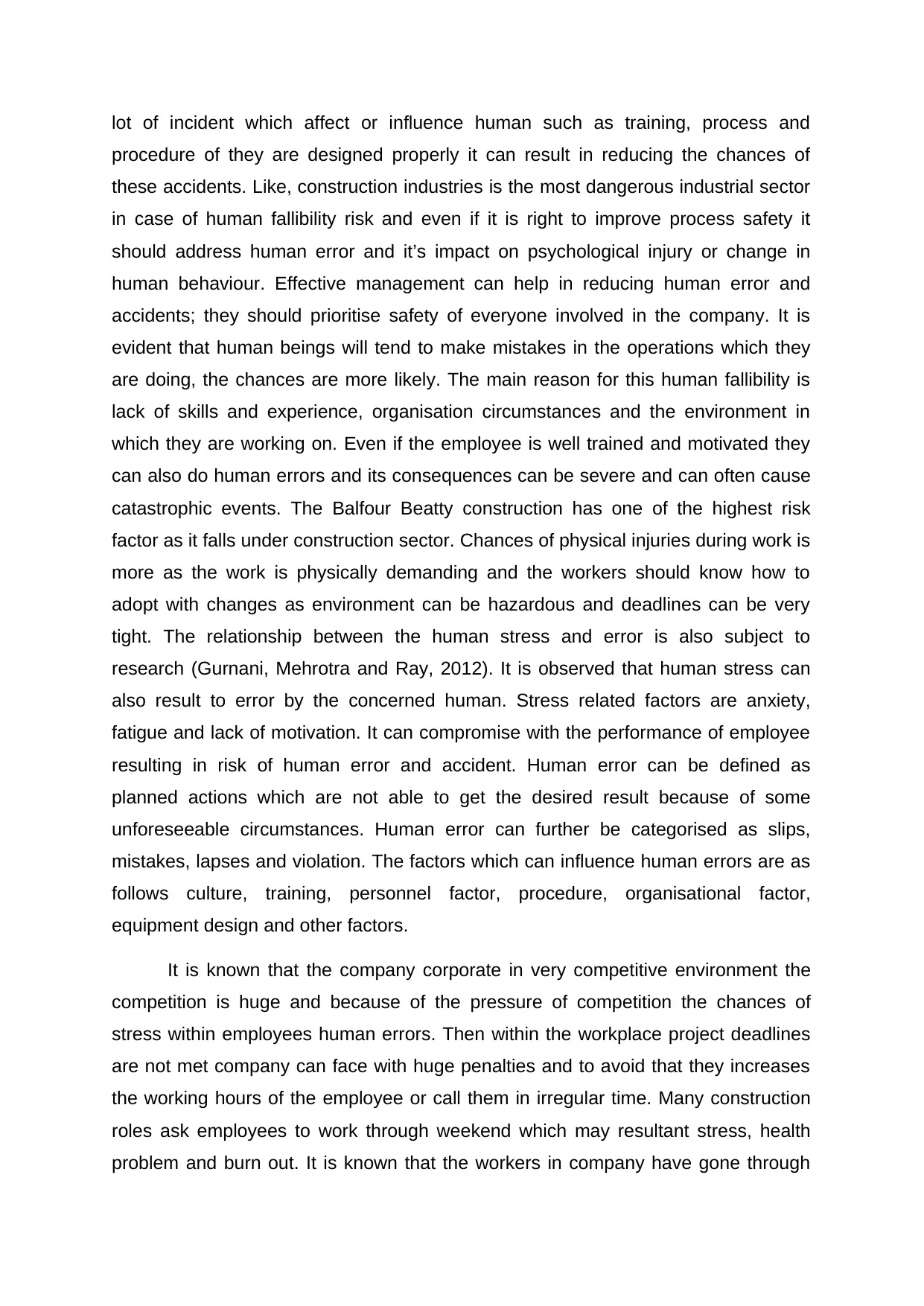
lot of incident which affect or influence human such as training, process and
procedure of they are designed properly it can result in reducing the chances of
these accidents. Like, construction industries is the most dangerous industrial sector
in case of human fallibility risk and even if it is right to improve process safety it
should address human error and it’s impact on psychological injury or change in
human behaviour. Effective management can help in reducing human error and
accidents; they should prioritise safety of everyone involved in the company. It is
evident that human beings will tend to make mistakes in the operations which they
are doing, the chances are more likely. The main reason for this human fallibility is
lack of skills and experience, organisation circumstances and the environment in
which they are working on. Even if the employee is well trained and motivated they
can also do human errors and its consequences can be severe and can often cause
catastrophic events. The Balfour Beatty construction has one of the highest risk
factor as it falls under construction sector. Chances of physical injuries during work is
more as the work is physically demanding and the workers should know how to
adopt with changes as environment can be hazardous and deadlines can be very
tight. The relationship between the human stress and error is also subject to
research (Gurnani, Mehrotra and Ray, 2012). It is observed that human stress can
also result to error by the concerned human. Stress related factors are anxiety,
fatigue and lack of motivation. It can compromise with the performance of employee
resulting in risk of human error and accident. Human error can be defined as
planned actions which are not able to get the desired result because of some
unforeseeable circumstances. Human error can further be categorised as slips,
mistakes, lapses and violation. The factors which can influence human errors are as
follows culture, training, personnel factor, procedure, organisational factor,
equipment design and other factors.
It is known that the company corporate in very competitive environment the
competition is huge and because of the pressure of competition the chances of
stress within employees human errors. Then within the workplace project deadlines
are not met company can face with huge penalties and to avoid that they increases
the working hours of the employee or call them in irregular time. Many construction
roles ask employees to work through weekend which may resultant stress, health
problem and burn out. It is known that the workers in company have gone through
procedure of they are designed properly it can result in reducing the chances of
these accidents. Like, construction industries is the most dangerous industrial sector
in case of human fallibility risk and even if it is right to improve process safety it
should address human error and it’s impact on psychological injury or change in
human behaviour. Effective management can help in reducing human error and
accidents; they should prioritise safety of everyone involved in the company. It is
evident that human beings will tend to make mistakes in the operations which they
are doing, the chances are more likely. The main reason for this human fallibility is
lack of skills and experience, organisation circumstances and the environment in
which they are working on. Even if the employee is well trained and motivated they
can also do human errors and its consequences can be severe and can often cause
catastrophic events. The Balfour Beatty construction has one of the highest risk
factor as it falls under construction sector. Chances of physical injuries during work is
more as the work is physically demanding and the workers should know how to
adopt with changes as environment can be hazardous and deadlines can be very
tight. The relationship between the human stress and error is also subject to
research (Gurnani, Mehrotra and Ray, 2012). It is observed that human stress can
also result to error by the concerned human. Stress related factors are anxiety,
fatigue and lack of motivation. It can compromise with the performance of employee
resulting in risk of human error and accident. Human error can be defined as
planned actions which are not able to get the desired result because of some
unforeseeable circumstances. Human error can further be categorised as slips,
mistakes, lapses and violation. The factors which can influence human errors are as
follows culture, training, personnel factor, procedure, organisational factor,
equipment design and other factors.
It is known that the company corporate in very competitive environment the
competition is huge and because of the pressure of competition the chances of
stress within employees human errors. Then within the workplace project deadlines
are not met company can face with huge penalties and to avoid that they increases
the working hours of the employee or call them in irregular time. Many construction
roles ask employees to work through weekend which may resultant stress, health
problem and burn out. It is known that the workers in company have gone through
Paraphrase This Document
Need a fresh take? Get an instant paraphrase of this document with our AI Paraphraser
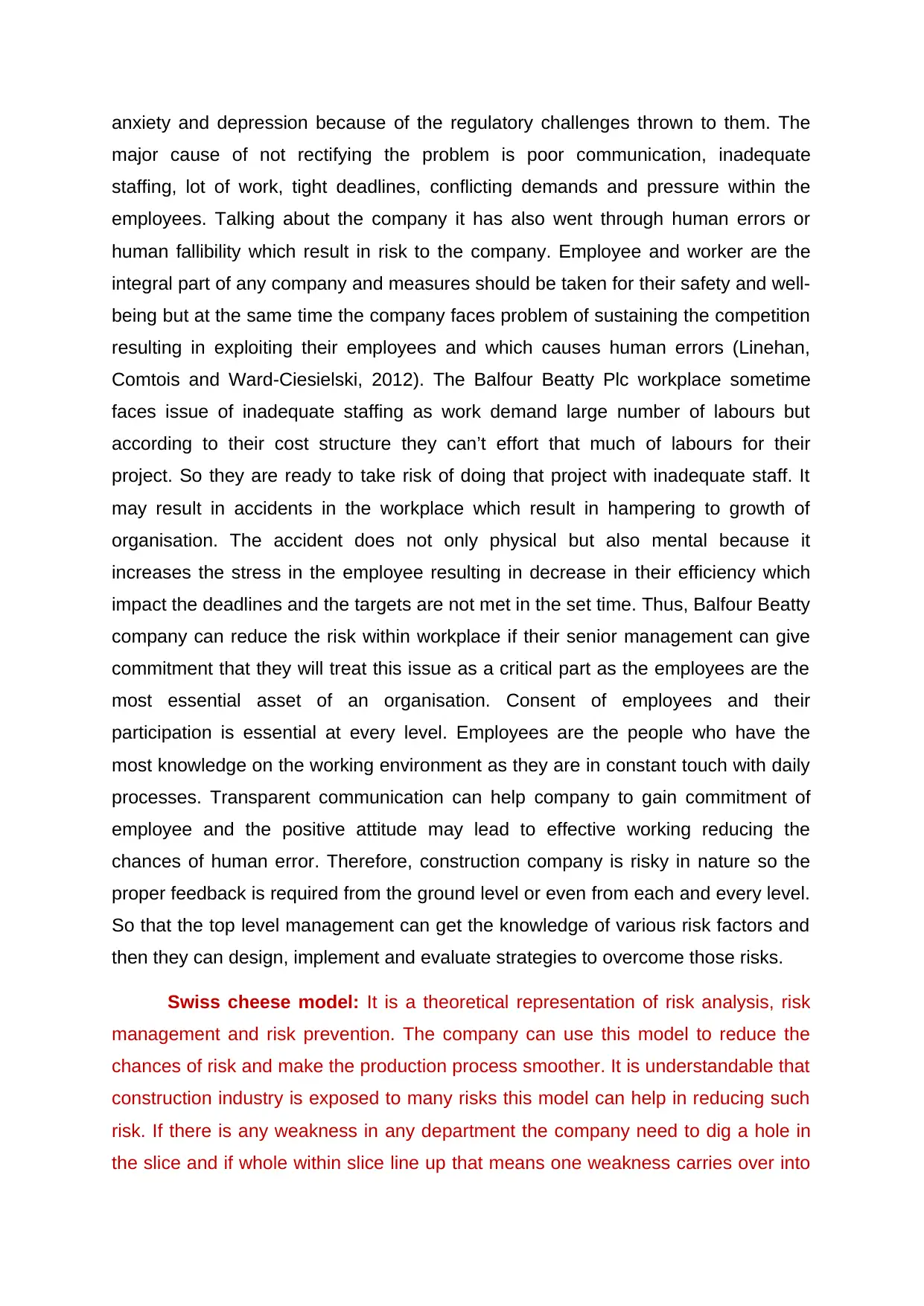
anxiety and depression because of the regulatory challenges thrown to them. The
major cause of not rectifying the problem is poor communication, inadequate
staffing, lot of work, tight deadlines, conflicting demands and pressure within the
employees. Talking about the company it has also went through human errors or
human fallibility which result in risk to the company. Employee and worker are the
integral part of any company and measures should be taken for their safety and well-
being but at the same time the company faces problem of sustaining the competition
resulting in exploiting their employees and which causes human errors (Linehan,
Comtois and Ward-Ciesielski, 2012). The Balfour Beatty Plc workplace sometime
faces issue of inadequate staffing as work demand large number of labours but
according to their cost structure they can’t effort that much of labours for their
project. So they are ready to take risk of doing that project with inadequate staff. It
may result in accidents in the workplace which result in hampering to growth of
organisation. The accident does not only physical but also mental because it
increases the stress in the employee resulting in decrease in their efficiency which
impact the deadlines and the targets are not met in the set time. Thus, Balfour Beatty
company can reduce the risk within workplace if their senior management can give
commitment that they will treat this issue as a critical part as the employees are the
most essential asset of an organisation. Consent of employees and their
participation is essential at every level. Employees are the people who have the
most knowledge on the working environment as they are in constant touch with daily
processes. Transparent communication can help company to gain commitment of
employee and the positive attitude may lead to effective working reducing the
chances of human error. Therefore, construction company is risky in nature so the
proper feedback is required from the ground level or even from each and every level.
So that the top level management can get the knowledge of various risk factors and
then they can design, implement and evaluate strategies to overcome those risks.
Swiss cheese model: It is a theoretical representation of risk analysis, risk
management and risk prevention. The company can use this model to reduce the
chances of risk and make the production process smoother. It is understandable that
construction industry is exposed to many risks this model can help in reducing such
risk. If there is any weakness in any department the company need to dig a hole in
the slice and if whole within slice line up that means one weakness carries over into
major cause of not rectifying the problem is poor communication, inadequate
staffing, lot of work, tight deadlines, conflicting demands and pressure within the
employees. Talking about the company it has also went through human errors or
human fallibility which result in risk to the company. Employee and worker are the
integral part of any company and measures should be taken for their safety and well-
being but at the same time the company faces problem of sustaining the competition
resulting in exploiting their employees and which causes human errors (Linehan,
Comtois and Ward-Ciesielski, 2012). The Balfour Beatty Plc workplace sometime
faces issue of inadequate staffing as work demand large number of labours but
according to their cost structure they can’t effort that much of labours for their
project. So they are ready to take risk of doing that project with inadequate staff. It
may result in accidents in the workplace which result in hampering to growth of
organisation. The accident does not only physical but also mental because it
increases the stress in the employee resulting in decrease in their efficiency which
impact the deadlines and the targets are not met in the set time. Thus, Balfour Beatty
company can reduce the risk within workplace if their senior management can give
commitment that they will treat this issue as a critical part as the employees are the
most essential asset of an organisation. Consent of employees and their
participation is essential at every level. Employees are the people who have the
most knowledge on the working environment as they are in constant touch with daily
processes. Transparent communication can help company to gain commitment of
employee and the positive attitude may lead to effective working reducing the
chances of human error. Therefore, construction company is risky in nature so the
proper feedback is required from the ground level or even from each and every level.
So that the top level management can get the knowledge of various risk factors and
then they can design, implement and evaluate strategies to overcome those risks.
Swiss cheese model: It is a theoretical representation of risk analysis, risk
management and risk prevention. The company can use this model to reduce the
chances of risk and make the production process smoother. It is understandable that
construction industry is exposed to many risks this model can help in reducing such
risk. If there is any weakness in any department the company need to dig a hole in
the slice and if whole within slice line up that means one weakness carries over into
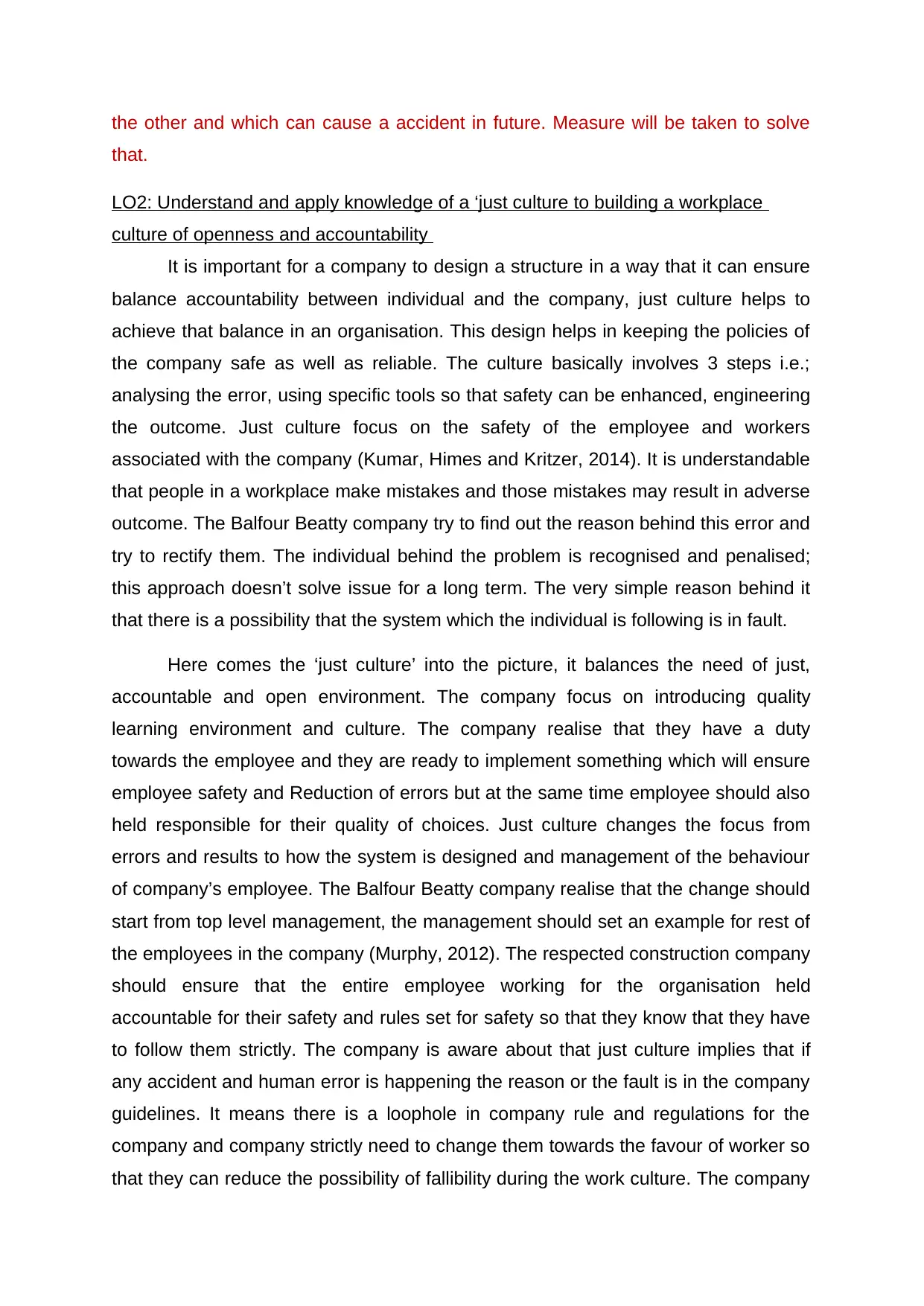
the other and which can cause a accident in future. Measure will be taken to solve
that.
LO2: Understand and apply knowledge of a ‘just culture to building a workplace
culture of openness and accountability
It is important for a company to design a structure in a way that it can ensure
balance accountability between individual and the company, just culture helps to
achieve that balance in an organisation. This design helps in keeping the policies of
the company safe as well as reliable. The culture basically involves 3 steps i.e.;
analysing the error, using specific tools so that safety can be enhanced, engineering
the outcome. Just culture focus on the safety of the employee and workers
associated with the company (Kumar, Himes and Kritzer, 2014). It is understandable
that people in a workplace make mistakes and those mistakes may result in adverse
outcome. The Balfour Beatty company try to find out the reason behind this error and
try to rectify them. The individual behind the problem is recognised and penalised;
this approach doesn’t solve issue for a long term. The very simple reason behind it
that there is a possibility that the system which the individual is following is in fault.
Here comes the ‘just culture’ into the picture, it balances the need of just,
accountable and open environment. The company focus on introducing quality
learning environment and culture. The company realise that they have a duty
towards the employee and they are ready to implement something which will ensure
employee safety and Reduction of errors but at the same time employee should also
held responsible for their quality of choices. Just culture changes the focus from
errors and results to how the system is designed and management of the behaviour
of company’s employee. The Balfour Beatty company realise that the change should
start from top level management, the management should set an example for rest of
the employees in the company (Murphy, 2012). The respected construction company
should ensure that the entire employee working for the organisation held
accountable for their safety and rules set for safety so that they know that they have
to follow them strictly. The company is aware about that just culture implies that if
any accident and human error is happening the reason or the fault is in the company
guidelines. It means there is a loophole in company rule and regulations for the
company and company strictly need to change them towards the favour of worker so
that they can reduce the possibility of fallibility during the work culture. The company
that.
LO2: Understand and apply knowledge of a ‘just culture to building a workplace
culture of openness and accountability
It is important for a company to design a structure in a way that it can ensure
balance accountability between individual and the company, just culture helps to
achieve that balance in an organisation. This design helps in keeping the policies of
the company safe as well as reliable. The culture basically involves 3 steps i.e.;
analysing the error, using specific tools so that safety can be enhanced, engineering
the outcome. Just culture focus on the safety of the employee and workers
associated with the company (Kumar, Himes and Kritzer, 2014). It is understandable
that people in a workplace make mistakes and those mistakes may result in adverse
outcome. The Balfour Beatty company try to find out the reason behind this error and
try to rectify them. The individual behind the problem is recognised and penalised;
this approach doesn’t solve issue for a long term. The very simple reason behind it
that there is a possibility that the system which the individual is following is in fault.
Here comes the ‘just culture’ into the picture, it balances the need of just,
accountable and open environment. The company focus on introducing quality
learning environment and culture. The company realise that they have a duty
towards the employee and they are ready to implement something which will ensure
employee safety and Reduction of errors but at the same time employee should also
held responsible for their quality of choices. Just culture changes the focus from
errors and results to how the system is designed and management of the behaviour
of company’s employee. The Balfour Beatty company realise that the change should
start from top level management, the management should set an example for rest of
the employees in the company (Murphy, 2012). The respected construction company
should ensure that the entire employee working for the organisation held
accountable for their safety and rules set for safety so that they know that they have
to follow them strictly. The company is aware about that just culture implies that if
any accident and human error is happening the reason or the fault is in the company
guidelines. It means there is a loophole in company rule and regulations for the
company and company strictly need to change them towards the favour of worker so
that they can reduce the possibility of fallibility during the work culture. The company
⊘ This is a preview!⊘
Do you want full access?
Subscribe today to unlock all pages.

Trusted by 1+ million students worldwide
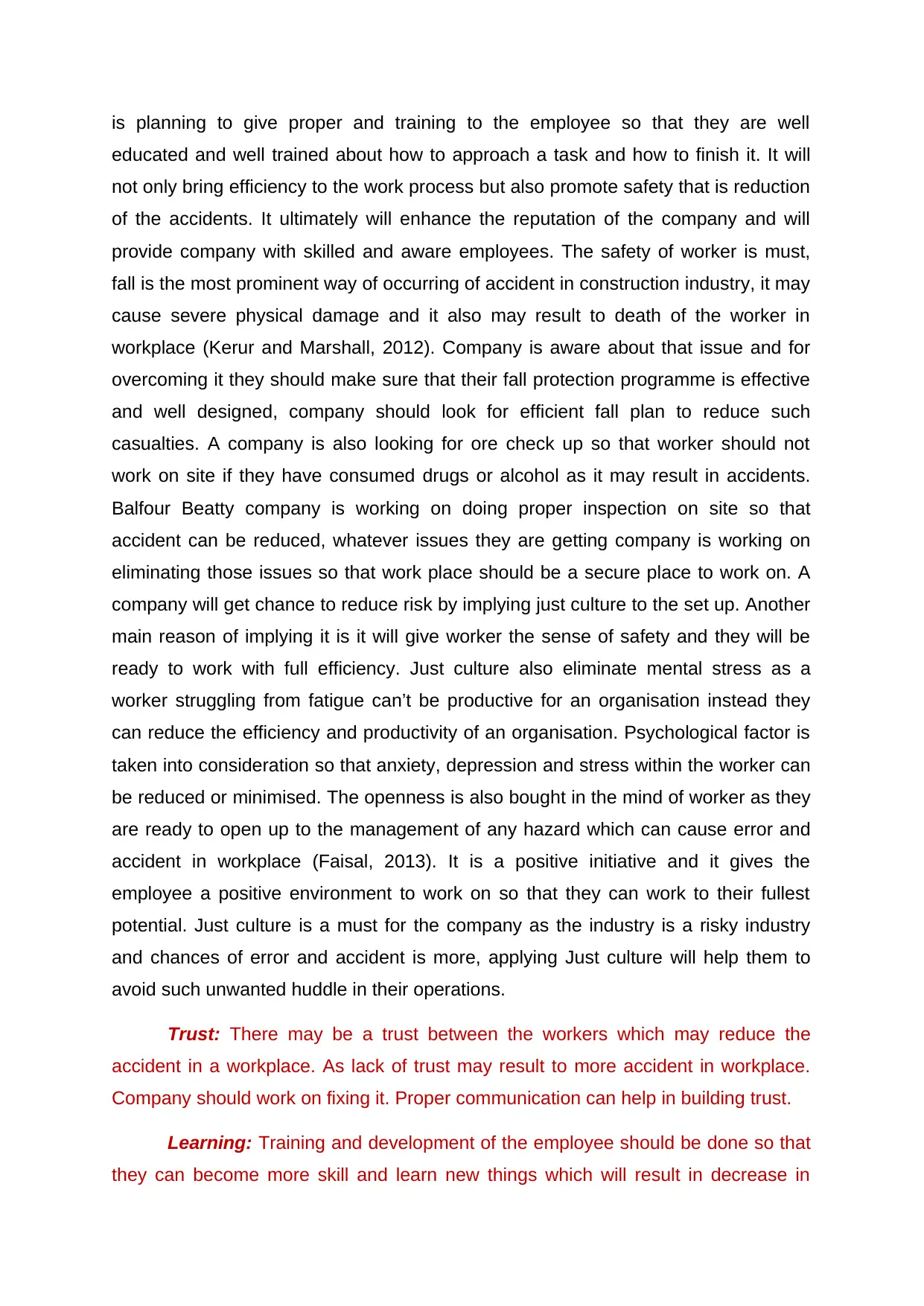
is planning to give proper and training to the employee so that they are well
educated and well trained about how to approach a task and how to finish it. It will
not only bring efficiency to the work process but also promote safety that is reduction
of the accidents. It ultimately will enhance the reputation of the company and will
provide company with skilled and aware employees. The safety of worker is must,
fall is the most prominent way of occurring of accident in construction industry, it may
cause severe physical damage and it also may result to death of the worker in
workplace (Kerur and Marshall, 2012). Company is aware about that issue and for
overcoming it they should make sure that their fall protection programme is effective
and well designed, company should look for efficient fall plan to reduce such
casualties. A company is also looking for ore check up so that worker should not
work on site if they have consumed drugs or alcohol as it may result in accidents.
Balfour Beatty company is working on doing proper inspection on site so that
accident can be reduced, whatever issues they are getting company is working on
eliminating those issues so that work place should be a secure place to work on. A
company will get chance to reduce risk by implying just culture to the set up. Another
main reason of implying it is it will give worker the sense of safety and they will be
ready to work with full efficiency. Just culture also eliminate mental stress as a
worker struggling from fatigue can’t be productive for an organisation instead they
can reduce the efficiency and productivity of an organisation. Psychological factor is
taken into consideration so that anxiety, depression and stress within the worker can
be reduced or minimised. The openness is also bought in the mind of worker as they
are ready to open up to the management of any hazard which can cause error and
accident in workplace (Faisal, 2013). It is a positive initiative and it gives the
employee a positive environment to work on so that they can work to their fullest
potential. Just culture is a must for the company as the industry is a risky industry
and chances of error and accident is more, applying Just culture will help them to
avoid such unwanted huddle in their operations.
Trust: There may be a trust between the workers which may reduce the
accident in a workplace. As lack of trust may result to more accident in workplace.
Company should work on fixing it. Proper communication can help in building trust.
Learning: Training and development of the employee should be done so that
they can become more skill and learn new things which will result in decrease in
educated and well trained about how to approach a task and how to finish it. It will
not only bring efficiency to the work process but also promote safety that is reduction
of the accidents. It ultimately will enhance the reputation of the company and will
provide company with skilled and aware employees. The safety of worker is must,
fall is the most prominent way of occurring of accident in construction industry, it may
cause severe physical damage and it also may result to death of the worker in
workplace (Kerur and Marshall, 2012). Company is aware about that issue and for
overcoming it they should make sure that their fall protection programme is effective
and well designed, company should look for efficient fall plan to reduce such
casualties. A company is also looking for ore check up so that worker should not
work on site if they have consumed drugs or alcohol as it may result in accidents.
Balfour Beatty company is working on doing proper inspection on site so that
accident can be reduced, whatever issues they are getting company is working on
eliminating those issues so that work place should be a secure place to work on. A
company will get chance to reduce risk by implying just culture to the set up. Another
main reason of implying it is it will give worker the sense of safety and they will be
ready to work with full efficiency. Just culture also eliminate mental stress as a
worker struggling from fatigue can’t be productive for an organisation instead they
can reduce the efficiency and productivity of an organisation. Psychological factor is
taken into consideration so that anxiety, depression and stress within the worker can
be reduced or minimised. The openness is also bought in the mind of worker as they
are ready to open up to the management of any hazard which can cause error and
accident in workplace (Faisal, 2013). It is a positive initiative and it gives the
employee a positive environment to work on so that they can work to their fullest
potential. Just culture is a must for the company as the industry is a risky industry
and chances of error and accident is more, applying Just culture will help them to
avoid such unwanted huddle in their operations.
Trust: There may be a trust between the workers which may reduce the
accident in a workplace. As lack of trust may result to more accident in workplace.
Company should work on fixing it. Proper communication can help in building trust.
Learning: Training and development of the employee should be done so that
they can become more skill and learn new things which will result in decrease in
Paraphrase This Document
Need a fresh take? Get an instant paraphrase of this document with our AI Paraphraser
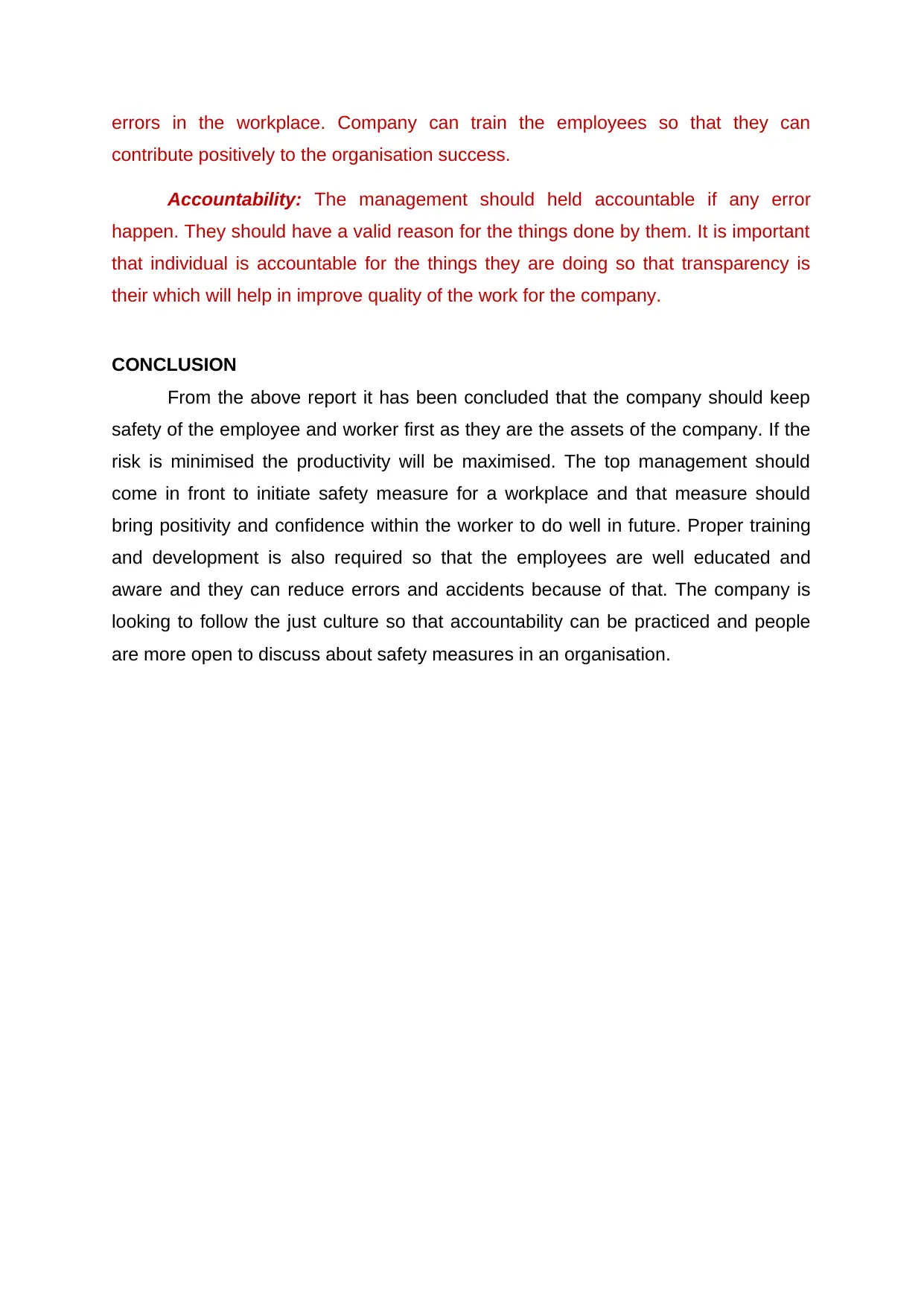
errors in the workplace. Company can train the employees so that they can
contribute positively to the organisation success.
Accountability: The management should held accountable if any error
happen. They should have a valid reason for the things done by them. It is important
that individual is accountable for the things they are doing so that transparency is
their which will help in improve quality of the work for the company.
CONCLUSION
From the above report it has been concluded that the company should keep
safety of the employee and worker first as they are the assets of the company. If the
risk is minimised the productivity will be maximised. The top management should
come in front to initiate safety measure for a workplace and that measure should
bring positivity and confidence within the worker to do well in future. Proper training
and development is also required so that the employees are well educated and
aware and they can reduce errors and accidents because of that. The company is
looking to follow the just culture so that accountability can be practiced and people
are more open to discuss about safety measures in an organisation.
contribute positively to the organisation success.
Accountability: The management should held accountable if any error
happen. They should have a valid reason for the things done by them. It is important
that individual is accountable for the things they are doing so that transparency is
their which will help in improve quality of the work for the company.
CONCLUSION
From the above report it has been concluded that the company should keep
safety of the employee and worker first as they are the assets of the company. If the
risk is minimised the productivity will be maximised. The top management should
come in front to initiate safety measure for a workplace and that measure should
bring positivity and confidence within the worker to do well in future. Proper training
and development is also required so that the employees are well educated and
aware and they can reduce errors and accidents because of that. The company is
looking to follow the just culture so that accountability can be practiced and people
are more open to discuss about safety measures in an organisation.
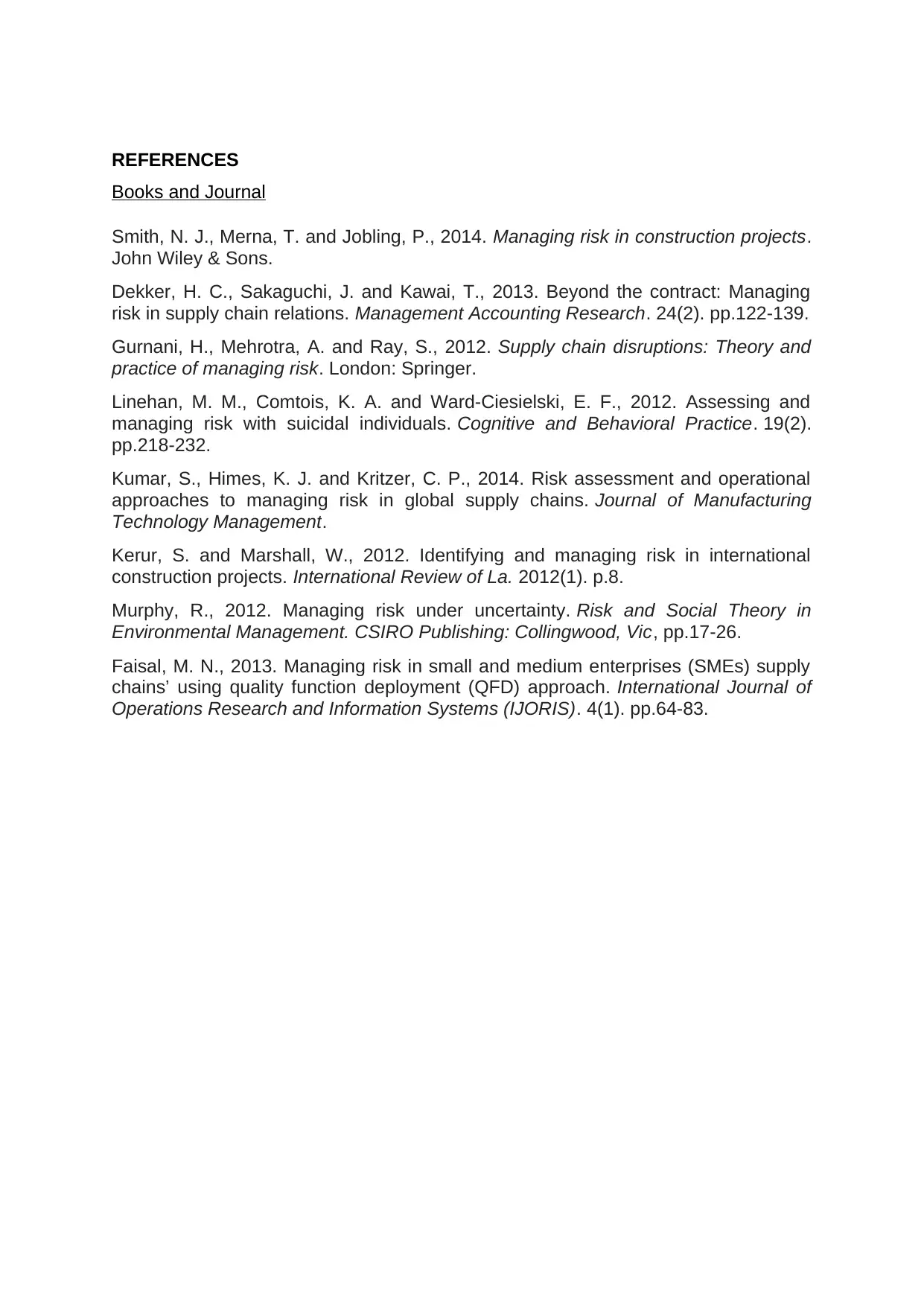
REFERENCES
Books and Journal
Smith, N. J., Merna, T. and Jobling, P., 2014. Managing risk in construction projects.
John Wiley & Sons.
Dekker, H. C., Sakaguchi, J. and Kawai, T., 2013. Beyond the contract: Managing
risk in supply chain relations. Management Accounting Research. 24(2). pp.122-139.
Gurnani, H., Mehrotra, A. and Ray, S., 2012. Supply chain disruptions: Theory and
practice of managing risk. London: Springer.
Linehan, M. M., Comtois, K. A. and Ward-Ciesielski, E. F., 2012. Assessing and
managing risk with suicidal individuals. Cognitive and Behavioral Practice. 19(2).
pp.218-232.
Kumar, S., Himes, K. J. and Kritzer, C. P., 2014. Risk assessment and operational
approaches to managing risk in global supply chains. Journal of Manufacturing
Technology Management.
Kerur, S. and Marshall, W., 2012. Identifying and managing risk in international
construction projects. International Review of La. 2012(1). p.8.
Murphy, R., 2012. Managing risk under uncertainty. Risk and Social Theory in
Environmental Management. CSIRO Publishing: Collingwood, Vic, pp.17-26.
Faisal, M. N., 2013. Managing risk in small and medium enterprises (SMEs) supply
chains’ using quality function deployment (QFD) approach. International Journal of
Operations Research and Information Systems (IJORIS). 4(1). pp.64-83.
Books and Journal
Smith, N. J., Merna, T. and Jobling, P., 2014. Managing risk in construction projects.
John Wiley & Sons.
Dekker, H. C., Sakaguchi, J. and Kawai, T., 2013. Beyond the contract: Managing
risk in supply chain relations. Management Accounting Research. 24(2). pp.122-139.
Gurnani, H., Mehrotra, A. and Ray, S., 2012. Supply chain disruptions: Theory and
practice of managing risk. London: Springer.
Linehan, M. M., Comtois, K. A. and Ward-Ciesielski, E. F., 2012. Assessing and
managing risk with suicidal individuals. Cognitive and Behavioral Practice. 19(2).
pp.218-232.
Kumar, S., Himes, K. J. and Kritzer, C. P., 2014. Risk assessment and operational
approaches to managing risk in global supply chains. Journal of Manufacturing
Technology Management.
Kerur, S. and Marshall, W., 2012. Identifying and managing risk in international
construction projects. International Review of La. 2012(1). p.8.
Murphy, R., 2012. Managing risk under uncertainty. Risk and Social Theory in
Environmental Management. CSIRO Publishing: Collingwood, Vic, pp.17-26.
Faisal, M. N., 2013. Managing risk in small and medium enterprises (SMEs) supply
chains’ using quality function deployment (QFD) approach. International Journal of
Operations Research and Information Systems (IJORIS). 4(1). pp.64-83.
⊘ This is a preview!⊘
Do you want full access?
Subscribe today to unlock all pages.

Trusted by 1+ million students worldwide
1 out of 9
Related Documents
Your All-in-One AI-Powered Toolkit for Academic Success.
+13062052269
info@desklib.com
Available 24*7 on WhatsApp / Email
![[object Object]](/_next/static/media/star-bottom.7253800d.svg)
Unlock your academic potential
Copyright © 2020–2025 A2Z Services. All Rights Reserved. Developed and managed by ZUCOL.





